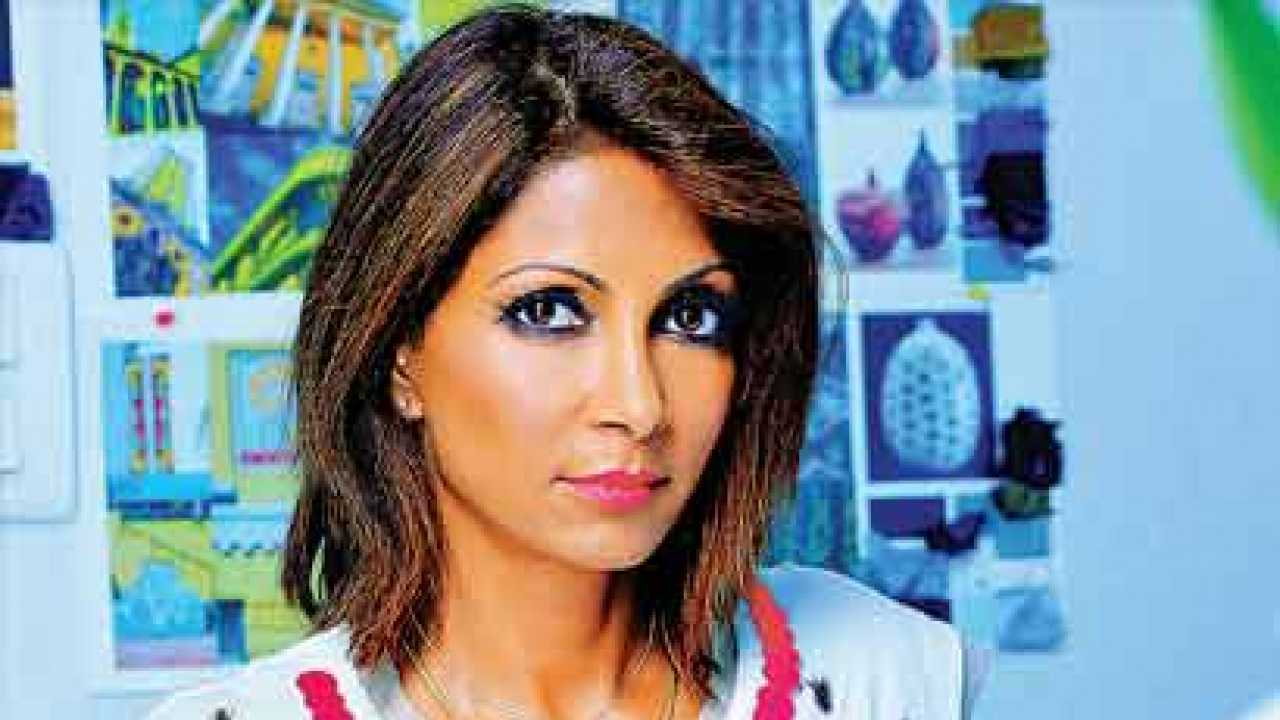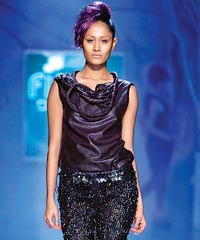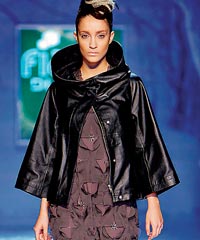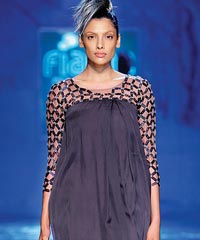
Fashion designer Sanchita Ajjampur is a classic example of a woman who is always on the move and yet, finds time to meet friends, answer questions and relax. Recently nominated as the chairperson of The Indo Italian Chamber of Commerce and Industry for the south zone, including Karnataka and Goa, Sanchita talks about her long standing affair with fashion. Excerpts from the interview…
Since Wills India, you have been jet setting around the world quite a bit —  did you show anywhere else recently?
did you show anywhere else recently?
I had the privilege to do the show with Fiama this season at the WILFW 2012. It should be noted that we missed out some of the best Indian fashion designers at the Wills Autumn W inter 2012. With the fashion industry’s clashing of show dates for AW 12, it becomes quite a task to display your collection head to head with the other counterparts. So, one has to really choose where they have to showcase, however I couldn’t miss the opportunity of being there for my clients show at the Milan and Paris fashion weeks.
Please tell us a little about your Autumn-winter 2012-13 collection — what is the thought behind it? What are the garments, fabrics used and the colours etc?
The collection deepens the bond forged by fashion and art in a mix of avant-garde forms and modular pieces with a Western cut and feel, where utilitarian details and hi-tech arts and crafts create eye-catching counter points. In a dimensional play of cuts, layers, textural expressions, kinetic elements and fluid visual patterns, the collection translates Japanese influences, samurai aesthetics and kabuki motifs into a contemporary idiom, while alchemies and innovative approaches create a continuum of coordinated opposites. The focus is on body shape, motion and functional ease. The clothing is scripted into a subversive fashion commentary that pays tribute to the femininity and grace, vulnerability and valour, dreams and desires of the modern woman, giving the collection a unique urban vibe.
You’re often called the designer who’s ahead of her time— do you think in India, it works as a disadvantage at times?
I wouldn’t say so. I could say I’m planned ahead. Gone are the times when consumers preferred to be spoon-fed changes. It used to take real visionaries to adopt new ideas and, unfortunately, they were few and far between. India has moved far ahead from this condition. You can see Indian designs and crafts embraced and used in the foreign markets and vice versa, and its self explanatory to see so many giants in the fashion industry spreading their tentacles here in India. Staying ahead of the game is a lot easier than flowing along with the trend.
This year, across the various fashion weeks, did you notice any old trend coming back in men and women’s wear?
Come spring- summer- fall-winter, there is no trend in fashion at all. It is a melting pot of ’90s influences, hip-hop styling and classic rock looks, with plenty of retro silhouettes, washed-out denim finishes, ext reme surface decoration and hand-customisation. The bell bottoms and the high waist pants, halter tops which went into slumber in the ’70s are up and on the ramp. The retro and punk styles are back. Printed, embellished leggings with trimmed laces, zipper-leg, pegged jeans, Capri pants and the bermuda shorts with some downsizing with more solid and subdued patterns, worn with long, tunic/trapeze style tops, tees with retro logos, the Edwardian slippers, the lace-up Victorian boot updated with high heels are all a come back.
reme surface decoration and hand-customisation. The bell bottoms and the high waist pants, halter tops which went into slumber in the ’70s are up and on the ramp. The retro and punk styles are back. Printed, embellished leggings with trimmed laces, zipper-leg, pegged jeans, Capri pants and the bermuda shorts with some downsizing with more solid and subdued patterns, worn with long, tunic/trapeze style tops, tees with retro logos, the Edwardian slippers, the lace-up Victorian boot updated with high heels are all a come back.
How hard is it to convince people of the way you choose to design as far as your innovations are concerned?
I have never had a condition. I create clothes that are borderless, and have valued customers who embrace the work and the uniqueness of my designs. Every product I create is researched thoroughly from the inspiration that has a global appeal to the final outcome. When I design a collection, the story unfolds, like a film in my mind’s eye, I also think about the tools needed to make it a reality, which is when knowledge and skill come into play, like a jigsaw puzzle, putting all the pieces together to form the bigger picture. The notion is to transform eclecticism and not lose touch with our own individuality or risk falling into the trap of banality and blandness.
What are some of the hurdles you think designers in India have to cope with?
The quality versus price conundrum is a tough one for designers. I believe that design should not be driven by markets, but by creativity, followed by wearability. The brand should sell a vision and a masstige product can sometimes make the brand lose its lustre. The element is to return to the craft, the problem with luxury or even masstige fashion apparel is that if it’s not based on the craft, these days it’s simply too hard to compete with the Zaras of the world.
A lot of attention is being given to international labels in India. Do you think if that much attention and focus was paid to Indian designers, the fashion  industry here could benefit a lot more?
industry here could benefit a lot more?
Today Indian women have more financial independence and exposure to information and technology — including knowledge of international brands and they discover things relevant to their interests. Fashion now is about clashing cultures, aesthetics and lifestyles that fuse at the point of impact. New links are forged in hyper-culture leading to cultural collaboration rather than cultural colonization. Competition always is good and is motivating to push you ahead. The world has open arms towards creativity and it doesn’t matter where you sell.
Tell us a little bit about customer behavior across the cities you’re available at — in India and abroad?
Though in India, customers prefer cultural clothing, women of the 21st century romance fashion, fusing classic with contemporary updates of silhouettes and proportions, combining both with fabric developments and technology for a true past meets future romance; Indian women don’t let go of their roots and Indian fashion is very much part of their identity.
Customers now want to hear the quiet messages, addressing their craving for balance and allowing the plain, the oh-so-simple to stand out, offering a new view of luxury — one that both challenges and inspires, while giving them a more sustainable future.